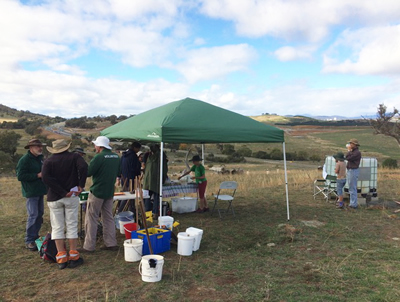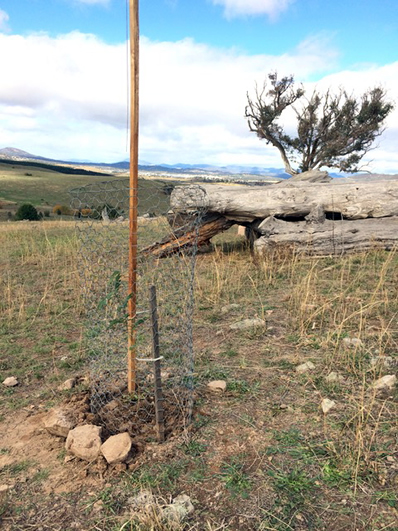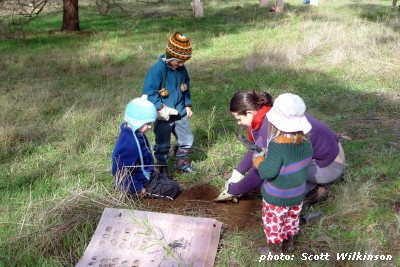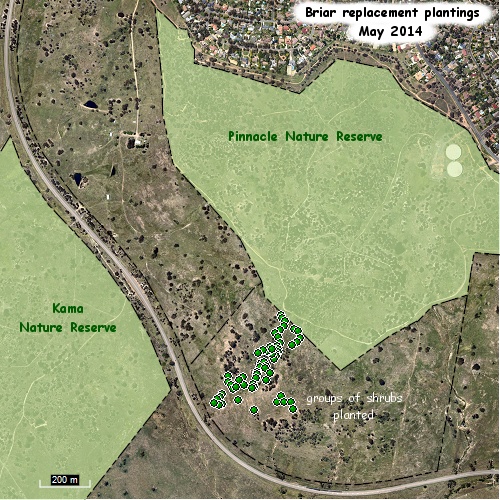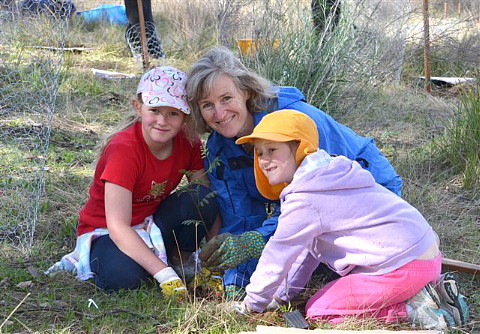  |
revegetation |
|
see also ground cover restoration Background The current level of vegetation in the Pinnacle Nature Reserve owes much to the enthusiastic work of the "Pinnacle Environment Group", a forerunner of Friends of the Pinnacle. In the 1990s this group carried out a series of tree plantings across the Reserve that arguably transformed it from a cleared grazing property to the attractive Reserve that it is today. Nevertheless, there are still areas of the Reserve that could benefit from further revegetation. Early in 2011, a group of fotpins, frustrated by incessant weeding, started looking at how we could constructively improve the existing vegetation in the Pinnacle Nature Reserve. Consultations with experts in the area of revegetation and native plant propagation persuaded us to scale back our initial grandiose plans and focus on targeted strategies aimed at increasing the complexity and diversity of the existing vegetation. This applies particularly to areas that were planted in the 90s, when the focus was on simply getting as many trees and shrubs into the ground as could be managed in the available time. While the massive plantings of the early 90s have produced a reserve with generally good woodland connectivity throughout, the plantings themselves frequently lack an understorey or mid-storey, reducing their value as ecosystems and leaving them vulnerable to weed infestations. We concluded that our energies and resources could best be utilised by focusing on what was missing from the existing woodland and filling the empty niches in the ecosystems, rather than trying to create new tracts of woodland from scratch. Briar Rose Replacement Program (BRRP) Since 2014, fotpin has been working in collaboration with the ACT Government's Parks & Conservation Service and Greening Australia, on a Briar Rose Replacement Program (or BRRP as we like to call it) in the Pinnacle Nature Reserve and the adjacent leasehold properties. The program is expected to run for a couple of years and aims to replace the many hundreds of medium sized briar rose plants and other woody weeds that we have removed and/or sprayed since our weed control program began. Woody weeds provide important shelter and habitat for small birds and other creatures, their root systems assist in preventing erosion, and they provide important connectivity for the movement of local birds and animals, so it is important that we find effective substitutes when we remove them. To this end, we'll be conducting a series of planting events over the coming years, re-introducing native shrubs and groundcover plants in carefully selected locations that will enhance connectivity and diversity.
Revegetation Activities to date: see also ground cover restoration
May 2019 Island Plantings in Bottom Pinnacle Fotpin’s first planting day for four years, held on 5 May 2019 was very successful. The day was bright and clear, though with a nasty, cold southerly wind. (I was reminded of a comment from a recent arrival from Darwin, who said: “It’s (expletive deleted) freezing and you keep saying ‘It’s a bit fresh.’ ”). This day rated as a bit nippy, at least.
By about 10.30, all one hundred plants had been planted, with only watering to be done, so we took a break for a very welcome morning tea or coffee, with cakes or savoury nibbles, provided by fotpin members. Watering didn’t take long, and the task of cleaning up and stowing away all the equipment happened in record time. Once we got back to the parking area near De Salis Street, the wind was blocked by the ridge behind us and it seemed surprisingly warm. Well, that’s Canberra in Autumn. All in all, a very productive and enjoyable time: a job well done, all down to volunteers, with help from the professionals. Thank you so much everyone – we couldn’t do it without you all.
Elizabeth Smith 24 May 2019
April 2015 Ground-layer and Shrub-layer Planting On April 26 there was a small planting event (about 120 plants ) aimed at improving the ground-layer and shrub-layer surrounding the trees straddling the Valley Track in the Dam and Central Paddocks, north-west of the Dam. This area is currently nearly devoid of any shrubs and ground-layer native species, and the aim is to enhance the bird habitat. See the map above for the location of the planting.
2014 Briar Rose Replacement Planting in Bottom Pinnacle gullies (10th May) The first of Briar Rose Replacement Program plantings was held on Saturday May 10th and planted around 250 shrubs and groundcover plants. These were planted in groups of about 4 plants in strategic locations to provide small bird habitat in and around one of the key gullies, enhancing the existing vegetation and the connection between the Pinnacle Nature Reserve to the neighbouring Kama Nature Reserve to the southwest (see map below). Funded by the ACT Government's Woodland Restoration Project, Greening Australia augered the holes for us and provided the plants. A grant from the Lower Molonglo Catchment Group provided funding for biodegradable shrub guards and stakes.
October 2013 Forest/Kama Boundary Planting (7th October) This small planting event only involved around 100 plants in the area just south of the Forest block. Our aim with this planting was to complement the trees that were planted there in the 1990s by adding shrubs and some groundcover plants such as daisies and native grasses. See the map above for the location of the planting.
May 2013 North Kama Planting (19th May) This is the next step in the ACT Government's Woodland Restoration Project in the Belconnen Hills (see below), which is aimed at establishing wildlife corridors around the ACT. This planting is sited to help bridge the gap between the Pinnacle Nature Reserve and the Kama Nature reserve on the other side of William Hovell Drive. It comprises 300 plants. As with our planting in September 2012, Greening Australia pre-dug all the holes and provided the plants, tree guards and the necessary tools. See the map above for the location of the planting.
2012 Family Planting Day (1st September) Since planning began for the 2011 planting, we've seen the emergence of the ACT Woodland Restoration Project. This is an ACT Government funded project that will see strategic plantings take place throughout the ACT over the next 3 years. The aim of these plantings is to establish viable wildlife corridors between Canberra's suburban reserves and the surrounding bush. It arose from the ACT Lowland Conservation Strategy (2004) [ One part of this strategy aims to establish a wildlife corridor between Black Mountain and the Murrumbidgee, encompassing the Belconnen Hills reserves (Aranda Bushland, Mt Painter and the Pinnacle) as well as the Cook horse paddocks, Bottom Pinnacle, North Kama, Kama Nature Reserve and the Woodstock Nature Reserve in the lower Molonglo valley. The extent of this program is described in the Belconnen Hills Woodlands Restoration Workplan [ On a lovely first day of Spring, 35 fotpin volunteers gathered for our Family Planting Day that saw the first and largest of the Pinnacle plantings under this scheme. See the map above for the location of the planting. Roughly 450 tubestock, including Yellow Box (E. melliodora), Blakely's Red Gum (E. blakelyii) and Native Blackthorn (Bursaria spinosa), were planted along both sides of Deep Creek in Bottom Pinnacle. The areas planted are clearly visible looking south from the pumphouse, and help form a corridor of vegetation between the Pinnacle Nature Reserve and the Molonglo. We were very fortunate to have the ACT Minister for Environment and Sustainable Development, Simon Corbell MLA, join us and help with the plantings, and share with us his views on The Pinnacle, the Belconnen Hills corridor and the Woodlands Plan. Having completed the planting by lunchtime, everyone tucked into a sausage sandwich or two and left satisfied at a job well done. Fotpin weeders agreed the general area of this planting becomes a new priority for our weed control activities. fotpin is grateful to the Greening Australia team, led by Ian Rayner, for their cooperation and excellent organisation of this event. For images of the day, see the 2012 Family Planting Day Photo Gallery.
2011 Pilot Planting Project In March 2011, through our consultations with other Parkcare groups, we became aware of a grant for planting projects being offered by Spicers Paper through Landcare Australia. Initially we were reluctant to apply for the grant, since the time frame was quite short and we did not want to be rushed into making decisions we might regret later. However, eventually we were persuaded that a small-scale pilot project would meet the requirements of the grant and provide us with an opportunity to gain some experience that would feed into larger projects down the track. This led to a community planting day on 9 October 2011. On that day a total of 218 trees, shrubs and groundcover species were planted in the northwest corner of the Kama paddock. See the map above for the location of the planting. Click for a full report on the 2011 planting [
|
||||||||||||||||||||||||||||||||||||||||||
© Friends of The Pinnacle
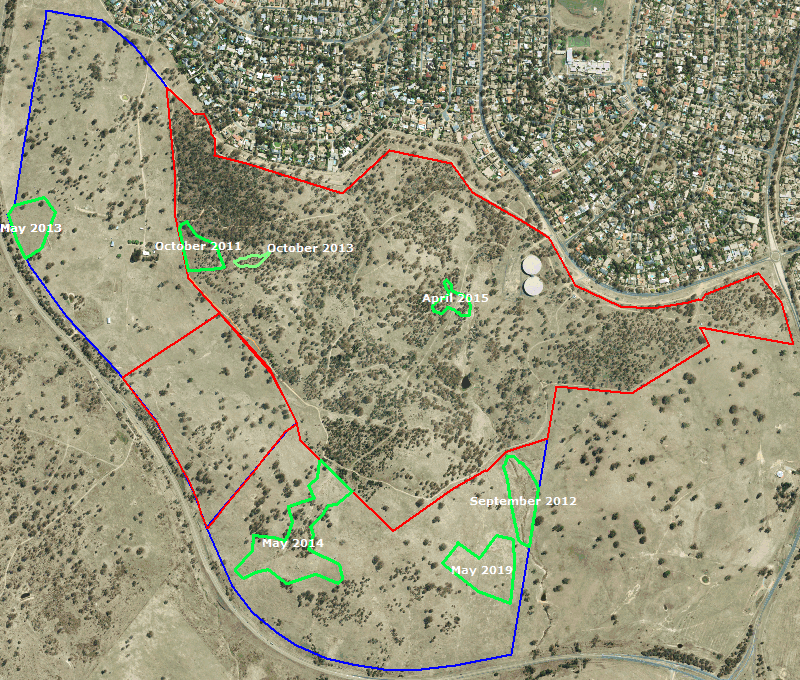
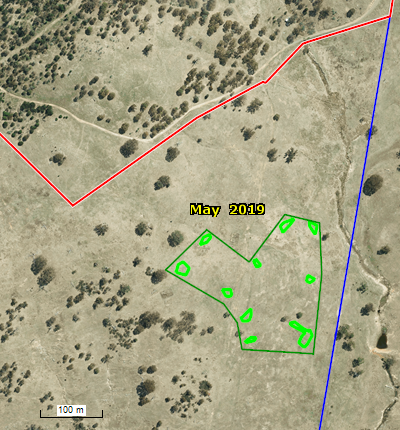
 John demonstrated what to do and everyone fell to with a will (partly to keep warm with exercise).
John demonstrated what to do and everyone fell to with a will (partly to keep warm with exercise).

